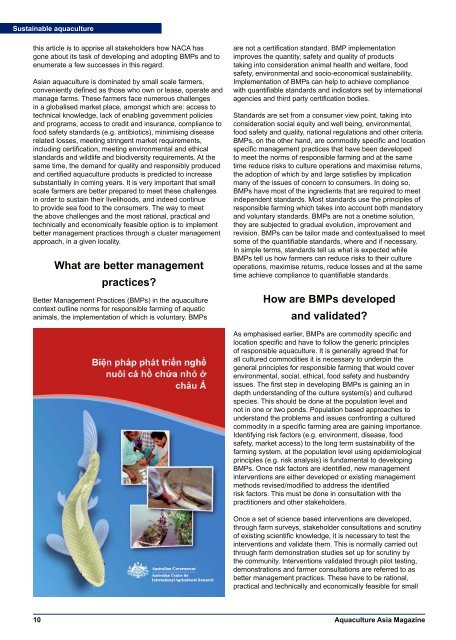Better Management Practices (BMPs) - Library - NACA
Better Management Practices (BMPs) - Library - NACA
Better Management Practices (BMPs) - Library - NACA
Create successful ePaper yourself
Turn your PDF publications into a flip-book with our unique Google optimized e-Paper software.
Sustainable aquaculture<br />
this article is to apprise all stakeholders how <strong>NACA</strong> has<br />
gone about its task of developing and adopting <strong>BMPs</strong> and to<br />
enumerate a few successes in this regard.<br />
Asian aquaculture is dominated by small scale farmers,<br />
conveniently defi ned as those who own or lease, operate and<br />
manage farms. These farmers face numerous challenges<br />
in a globalised market place, amongst which are: access to<br />
technical knowledge, lack of enabling government policies<br />
and programs, access to credit and insurance, compliance to<br />
food safety standards (e.g. antibiotics), minimising disease<br />
related losses, meeting stringent market requirements,<br />
including certifi cation, meeting environmental and ethical<br />
standards and wildlife and biodiversity requirements. At the<br />
same time, the demand for quality and responsibly produced<br />
and certifi ed aquaculture products is predicted to increase<br />
substantially in coming years. It is very important that small<br />
scale farmers are better prepared to meet these challenges<br />
in order to sustain their livelihoods, and indeed continue<br />
to provide sea food to the consumers. The way to meet<br />
the above challenges and the most rational, practical and<br />
technically and economically feasible option is to implement<br />
better management practices through a cluster management<br />
approach, in a given locality.<br />
What are better management<br />
practices?<br />
<strong>Better</strong> <strong>Management</strong> <strong>Practices</strong> (<strong>BMPs</strong>) in the aquaculture<br />
context outline norms for responsible farming of aquatic<br />
animals, the implementation of which is voluntary. <strong>BMPs</strong><br />
are not a certifi cation standard. BMP implementation<br />
improves the quantity, safety and quality of products<br />
taking into consideration animal health and welfare, food<br />
safety, environmental and socio-economical sustainability.<br />
Implementation of <strong>BMPs</strong> can help to achieve compliance<br />
with quantifi able standards and indicators set by international<br />
agencies and third party certifi cation bodies.<br />
Standards are set from a consumer view point, taking into<br />
consideration social equity and well being, environmental,<br />
food safety and quality, national regulations and other criteria.<br />
<strong>BMPs</strong>, on the other hand, are commodity specifi c and location<br />
specifi c management practices that have been developed<br />
to meet the norms of responsible farming and at the same<br />
time reduce risks to culture operations and maximise returns,<br />
the adoption of which by and large satisfi es by implication<br />
many of the issues of concern to consumers. In doing so,<br />
<strong>BMPs</strong> have most of the ingredients that are required to meet<br />
independent standards. Most standards use the principles of<br />
responsible farming which takes into account both mandatory<br />
and voluntary standards. <strong>BMPs</strong> are not a onetime solution,<br />
they are subjected to gradual evolution, improvement and<br />
revision. <strong>BMPs</strong> can be tailor made and contextualised to meet<br />
some of the quantifi able standards, where and if necessary.<br />
In simple terms, standards tell us what is expected while<br />
<strong>BMPs</strong> tell us how farmers can reduce risks to their culture<br />
operations, maximise returns, reduce losses and at the same<br />
time achieve compliance to quantifi able standards.<br />
How are <strong>BMPs</strong> developed<br />
and validated?<br />
As emphasised earlier, <strong>BMPs</strong> are commodity specifi c and<br />
location specifi c and have to follow the generic principles<br />
of responsible aquaculture. It is generally agreed that for<br />
all cultured commodities it is necessary to underpin the<br />
general principles for responsible farming that would cover<br />
environmental, social, ethical, food safety and husbandry<br />
issues. The fi rst step in developing <strong>BMPs</strong> is gaining an in<br />
depth understanding of the culture system(s) and cultured<br />
species. This should be done at the population level and<br />
not in one or two ponds. Population based approaches to<br />
understand the problems and issues confronting a cultured<br />
commodity in a specifi c farming area are gaining importance.<br />
Identifying risk factors (e.g. environment, disease, food<br />
safety, market access) to the long term sustainability of the<br />
farming system, at the population level using epidemiological<br />
principles (e.g. risk analysis) is fundamental to developing<br />
<strong>BMPs</strong>. Once risk factors are identifi ed, new management<br />
interventions are either developed or existing management<br />
methods revised/modifi ed to address the identifi ed<br />
risk factors. This must be done in consultation with the<br />
practitioners and other stakeholders.<br />
Once a set of science based interventions are developed,<br />
through farm surveys, stakeholder consultations and scrutiny<br />
of existing scientifi c knowledge, it is necessary to test the<br />
interventions and validate them. This is normally carried out<br />
through farm demonstration studies set up for scrutiny by<br />
the community. Interventions validated through pilot testing,<br />
demonstrations and farmer consultations are referred to as<br />
better management practices. These have to be rational,<br />
practical and technically and economically feasible for small<br />
10 Aquaculture Asia Magazine

















